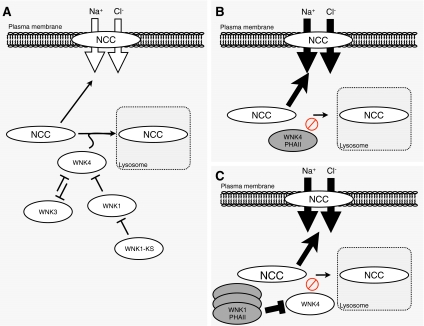Fig. 2.
The “inhibitory” pathway of WNK4. a WNK4 diverts NCC to the lysosomal compartment during forward trafficking of the cotransporter to the plasma membrane. WNK3 interacts with WNK4, potentially preventing the WNK4-induced shuttling of NCC to the lysosome. WNK1 also inhibits WNK4 by interacting with the protein. In addition, WNK1-KS acts by inhibiting WNK1, thereby releasing WNK1’s inhibition on WNK4, thus increasing the inhibitory effect of WNK4 upon NCC. b Potential mechanism by which loss-of-function mutations in WNK4 leads to PHAII. Loss-of-function mutations in WNK4 reduce the ability of the kinase to shuttle NCC to the lysosomes during forward trafficking, thereby increasing the abundance of the cotransporter in the apical plasma membrane. c An increase in the WNK1 protein occurs due to intronic deletion in its gene. Increased expression of WNK1 in this “inhibitory” pathway would lead to a marked inhibition of WNK4, thus increasing NCC membrane abundance and thereby causing PHAII

